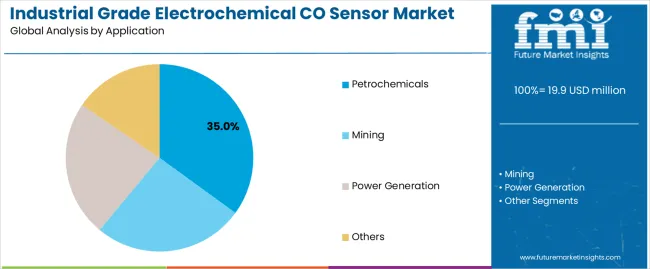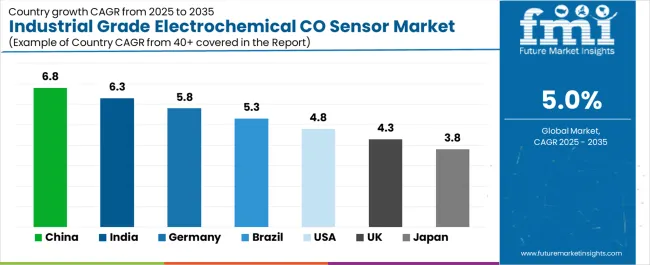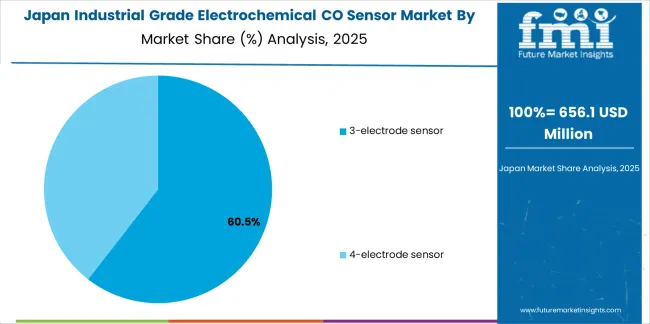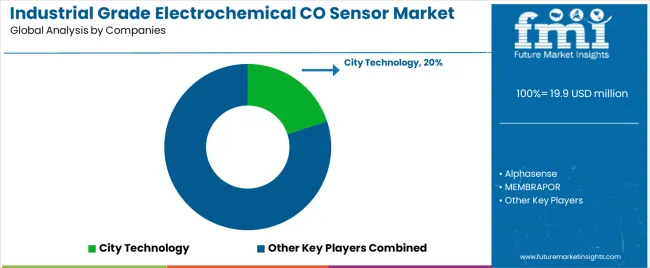The global industrial grade electrochemical CO sensor market is valued at USD 19.9 million in 2025. It is slated to reach USD 32.3 million by 2035, recording an absolute increase of USD 12.4 million over the forecast period. This translates into a total growth of 62.3%, with the market forecast to expand at a compound annual growth rate (CAGR) of 5% between 2025 and 2035. The overall market size is expected to grow by nearly 1.62X during the same period, supported by increasing demand for workplace safety monitoring in hazardous environments, growing adoption of gas detection systems in industrial facilities, and rising emphasis on occupational health standards across diverse petrochemical processing, mining operations, and power generation applications.
Between 2025 and 2030, the industrial grade electrochemical CO sensor market is projected to expand from USD 19.9 million to USD 25.3 million, resulting in a value increase of USD 5.4 million, which represents 43.5% of the total forecast growth for the decade. This phase of development will be shaped by increasing industrial safety regulations requiring continuous gas monitoring, rising adoption of portable and fixed gas detection systems, and growing demand for reliable carbon monoxide sensing in confined space entry and process safety applications. Industrial facility operators and safety equipment manufacturers are expanding their electrochemical CO sensor capabilities to address the growing demand for accurate and responsive gas detection solutions that ensure worker protection and regulatory compliance.

From 2030 to 2035, the market is forecast to grow from USD 25.3 million to USD 32.3 million, adding another USD 7 million, which constitutes 56.5% of the overall ten-year expansion. This period is expected to be characterized by the expansion of wireless gas monitoring networks and Internet of Things integration, the development of advanced sensor designs with extended operational lifetimes and improved selectivity, and the growth of specialized applications for industrial hygiene monitoring and environmental compliance programs. The growing adoption of connected safety systems and predictive maintenance platforms will drive demand for industrial grade electrochemical CO sensors with enhanced digital communication and diagnostic capabilities.
Between 2020 and 2025, the industrial grade electrochemical CO sensor market experienced steady growth, driven by increasing workplace safety awareness and growing recognition of electrochemical CO sensors as essential components for detecting toxic carbon monoxide gas in diverse industrial and confined space applications. The market developed as safety managers and industrial hygienists recognized the potential for electrochemical CO sensor technology to provide rapid response detection, maintain measurement accuracy, and support comprehensive worker protection programs while meeting regulatory monitoring requirements. Technological advancement in electrode materials and electrolyte formulations began emphasizing the critical importance of maintaining sensor stability and interference resistance in challenging industrial atmospheres.
| Metric | Value |
|---|---|
| Estimated Value in (2025E) | USD 19.9 million |
| Forecast Value in (2035F) | USD 32.3 million |
| Forecast CAGR (2025 to 2035) | 5% |
Market expansion is being supported by the increasing global emphasis on industrial safety and worker protection driven by occupational health regulations and incident prevention requirements, alongside the corresponding need for reliable gas detection technologies that can provide accurate carbon monoxide measurement, enable rapid hazard response, and maintain operational reliability across various petrochemical facilities, underground mining operations, and industrial power generation applications. Modern safety professionals and facility operators are increasingly focused on implementing electrochemical CO sensor solutions that can deliver continuous monitoring coverage, support compliance documentation, and provide dependable toxic gas detection in demanding industrial environments.
The growing emphasis on process safety management and confined space safety protocols is driving demand for industrial grade electrochemical CO sensors that can offer fast response times, enable portable and fixed monitoring configurations, and ensure comprehensive worker protection across diverse hazardous locations. Industrial organizations' preference for gas detection solutions that combine measurement accuracy with long-term stability and minimal maintenance requirements is creating opportunities for innovative electrochemical CO sensor implementations. The rising influence of wireless monitoring systems and connected safety platforms is also contributing to increased adoption of electrochemical CO sensors that can provide remote data transmission without compromising detection performance or operational simplicity.
The market is segmented by electrode configuration, application, and region. By electrode configuration, the market is divided into 3-electrode sensor and 4-electrode sensor. Based on application, the market is categorized into petrochemicals, mining, power generation, and others. Regionally, the market is divided into East Asia, Europe, North America, South Asia, Latin America, Middle East & Africa, and Eastern Europe.

The 3-electrode sensor segment is projected to maintain its leading position in the industrial grade electrochemical CO sensor market in 2025 with a 60% market share, reaffirming its role as the preferred electrode design for cost-effective carbon monoxide detection and general industrial monitoring applications. Safety equipment manufacturers and facility operators increasingly utilize 3-electrode electrochemical CO sensors for their simplified design characteristics, proven measurement capabilities, and effective performance in providing reliable carbon monoxide detection while maintaining manufacturing efficiency. 3-electrode sensor technology's proven effectiveness and application suitability directly address the industry requirements for economical gas detection and comprehensive safety monitoring across diverse industrial facilities and portable detection instruments.
This electrode configuration segment forms the foundation of industrial gas detection programs, as it represents the design with established manufacturing processes and proven performance record across multiple industrial applications and monitoring scenarios. Safety equipment industry investments in sensor manufacturing technologies continue to strengthen adoption among detector manufacturers and system integrators. With regulatory requirements demanding widespread gas monitoring coverage and cost-effective safety implementations, 3-electrode electrochemical CO sensors align with both economic objectives and detection performance requirements, making them the central component of comprehensive industrial safety strategies.

The petrochemicals application segment is projected to represent the largest share of industrial grade electrochemical CO sensor demand in 2025 with a 35% market share, underscoring its critical role as the primary driver for sensor adoption across chemical processing plants, refineries, and petrochemical manufacturing facilities. Petrochemical operators prefer electrochemical CO sensors for safety monitoring due to their reliable detection of carbon monoxide in process areas, proven performance in hydrocarbon-rich atmospheres, and ability to support worker protection while enabling regulatory compliance and process safety management. Positioned as essential components for modern petrochemical safety systems, industrial grade electrochemical CO sensors offer both hazard detection advantages and operational reliability.
The segment is supported by continuous expansion in petrochemical processing capacity and the growing implementation of comprehensive gas detection systems that enable enhanced worker safety with improved monitoring coverage and reduced incident risk. Additionally, petrochemical facilities are investing in advanced gas detection programs to support increasingly stringent safety regulations and operational demands for continuous toxic gas monitoring throughout process units and maintenance areas. As petrochemical industry complexity increases and safety standards advance, the petrochemicals application will continue to dominate the market while supporting advanced sensor technology utilization and comprehensive safety monitoring optimization.
The industrial grade electrochemical CO sensor market is advancing steadily due to increasing demand for workplace safety monitoring driven by occupational health regulations and growing implementation of gas detection requirements that necessitate sensor technologies providing accurate carbon monoxide measurement and reliable hazard warning capabilities across diverse petrochemical processing, underground mining, and industrial power generation applications. However, the market faces challenges, including sensor lifetime limitations requiring periodic replacement, interference from other gases in complex industrial atmospheres, and competition from alternative gas sensing technologies including infrared and metal oxide sensors. Innovation in electrode materials and electrolyte chemistry continues to influence product development and market expansion patterns.
The growing implementation of occupational safety regulations is driving demand for gas detection solutions that address mandatory monitoring requirements including continuous area monitoring, confined space entry verification, and personal exposure tracking for carbon monoxide hazards. Industrial safety applications require reliable electrochemical CO sensors that deliver consistent performance across extended operational periods while supporting compliance documentation and audit requirements. Safety managers are increasingly recognizing the operational advantages of electrochemical CO sensor integration for meeting regulatory obligations and preventing workplace incidents, creating opportunities for certified sensor products specifically designed for hazardous location installations and portable gas detection instruments.
Modern industrial grade electrochemical CO sensor manufacturers are incorporating wireless transmission capabilities and digital communication protocols to enhance monitoring system flexibility, enable remote data access, and support comprehensive safety management through centralized alarm handling and data logging platforms. Leading companies are developing sensors with Bluetooth connectivity, implementing industrial wireless standards, and advancing digital output interfaces that provide concentration data and diagnostic information to monitoring systems. These technologies improve safety program effectiveness while enabling new monitoring architectures, including distributed wireless networks, real-time safety dashboards, and predictive sensor replacement scheduling. Advanced connectivity integration also allows facility operators to support comprehensive safety optimization objectives and operational efficiency beyond traditional standalone detection instruments.
The expansion of remote facility monitoring and increasing demand for reduced maintenance burdens is driving development of electrochemical CO sensors with extended operational lifetimes and improved stability characteristics. These advanced applications require optimized electrode designs and enhanced electrolyte formulations that enable multi-year sensor operation without performance degradation, creating premium market segments with differentiated value propositions. Manufacturers are investing in advanced materials research and accelerated aging testing to serve industrial operators seeking minimal sensor replacement frequency and maximum monitoring reliability while supporting innovation in offshore installations, remote mining operations, and unmanned facility monitoring applications.

| Country | CAGR (2025-2035) |
|---|---|
| China | 6.8% |
| India | 6.3% |
| Germany | 5.8% |
| Brazil | 5.3% |
| United States | 4.8% |
| United Kingdom | 4.3% |
| Japan | 3.8% |
The industrial grade electrochemical CO sensor market is experiencing solid growth globally, with China leading at a 6.8% CAGR through 2035, driven by massive industrial expansion, growing workplace safety enforcement, and increasing adoption of gas detection systems in chemical processing and manufacturing facilities. India follows at 6.3%, supported by industrial development, expanding mining sector, and increasing emphasis on occupational safety standards across manufacturing industries. Germany shows growth at 5.8%, emphasizing industrial safety excellence, chemical industry leadership, and comprehensive workplace protection regulations requiring advanced gas monitoring. Brazil demonstrates 5.3% growth, supported by mining industry safety requirements, petrochemical sector expansion, and growing industrial safety awareness driving gas detection adoption. The United States records 4.8%, focusing on OSHA compliance requirements, chemical facility regulations, and established industrial hygiene practices requiring continuous gas monitoring. The United Kingdom exhibits 4.3% growth, emphasizing Health and Safety Executive standards, offshore platform safety, and industrial facility monitoring requirements. Japan shows 3.8% growth, supported by industrial safety culture, manufacturing sector quality standards, and comprehensive workplace safety practices.
The report covers an in-depth analysis of 40+ countries, the top-performing countries are highlighted below.

Revenue from industrial grade electrochemical CO sensors in China is projected to exhibit exceptional growth with a CAGR of 6.8% through 2035, driven by massive industrial expansion and increasing workplace safety enforcement supported by government occupational health initiatives and industrial accident prevention programs. The country's extensive manufacturing sector and growing emphasis on worker protection are creating substantial demand for electrochemical CO sensor solutions. Major gas detection equipment manufacturers and international sensor companies are establishing comprehensive production capabilities to serve both domestic markets and export opportunities.
Revenue from industrial grade electrochemical CO sensors in India is expanding at a CAGR of 6.3%, supported by the country's industrial development programs, expanding mining sector, and increasing adoption of workplace safety standards among manufacturing and extraction industries. The country's comprehensive industrial growth and rising safety awareness are driving demand for electrochemical CO sensor solutions throughout diverse industrial sectors. Leading gas detection equipment suppliers and sensor manufacturers are establishing distribution networks and technical support capabilities to address growing demand.
Revenue from industrial grade electrochemical CO sensors in Germany is expanding at a CAGR of 5.8%, supported by the country's industrial safety excellence, chemical industry leadership, and comprehensive workplace protection regulations requiring advanced gas monitoring systems. The nation's safety standards and engineering capabilities are driving sophisticated electrochemical CO sensor implementations throughout industrial sectors. Leading safety equipment manufacturers and sensor suppliers are investing extensively in advanced sensor technology development and application engineering.
Revenue from industrial grade electrochemical CO sensors in Brazil is expanding at a CAGR of 5.3%, supported by the country's mining industry safety requirements, petrochemical sector expansion, and growing industrial safety awareness driving gas detection adoption. Brazil's natural resource industries and industrial development are driving demand for electrochemical CO sensor technologies. Safety equipment distributors and gas detection system integrators are investing in market development to serve both mining and petrochemical sectors.
Revenue from industrial grade electrochemical CO sensors in the United States is expanding at a CAGR of 4.8%, supported by the country's OSHA compliance requirements, chemical facility regulations, and established industrial hygiene practices requiring continuous gas monitoring. The nation's comprehensive safety regulations and mature industrial sector are driving demand for reliable electrochemical CO sensor technologies. Gas detection equipment manufacturers and safety system providers are investing in product compliance and technical support to serve diverse industrial requirements.
Revenue from industrial grade electrochemical CO sensors in the United Kingdom is expanding at a CAGR of 4.3%, supported by the country's Health and Safety Executive standards, offshore platform safety requirements, and industrial facility monitoring regulations. The UK's safety regulatory framework and industrial sector are driving demand for electrochemical CO sensor solutions. Safety equipment suppliers and gas detection specialists are establishing comprehensive product offerings and technical support capabilities.

Revenue from industrial grade electrochemical CO sensors in Japan is expanding at a CAGR of 3.8%, supported by the country's industrial safety culture, manufacturing sector quality standards, and comprehensive workplace safety practices. Japan's technological sophistication and safety emphasis are driving demand for high-quality electrochemical CO sensor products. Gas detection equipment manufacturers and safety system providers are investing in product development for Japanese industrial requirements and quality expectations.

The industrial grade electrochemical CO sensor market in Europe is projected to grow from USD 7.3 million in 2025 to USD 11.8 million by 2035, registering a CAGR of 4.9% over the forecast period. Germany is expected to maintain leadership with a 28.9% market share in 2025, moderating to 28.6% by 2035, supported by industrial safety excellence, chemical industry leadership, and comprehensive workplace protection regulations.
France follows with 19.2% in 2025, projected at 19.4% by 2035, driven by chemical industry safety requirements, industrial facility regulations, and workplace protection standards. The United Kingdom holds 16.8% in 2025, expected to reach 16.5% by 2035 due to Health and Safety Executive standards and offshore platform safety requirements. Italy commands 13.5% in 2025, rising slightly to 13.7% by 2035, while Spain accounts for 10.2% in 2025, reaching 10.4% by 2035 aided by industrial sector growth and chemical facility safety requirements. The Netherlands maintains 4.9% in 2025, up to 5% by 2035 due to petrochemical industry concentration and port facility safety monitoring. The Rest of Europe region, including Nordics, Central & Eastern Europe, and other markets, is anticipated to hold 6.5% in 2025 and 6.4% by 2035, reflecting steady development in industrial safety standards, workplace monitoring requirements, and gas detection system adoption.

The industrial grade electrochemical CO sensor market is characterized by competition among established gas sensor manufacturers, specialized electrochemical sensor developers, and industrial safety equipment producers. Companies are investing in electrode material research, electrolyte formulation optimization, sensor lifetime enhancement, and application engineering support to deliver accurate, reliable, and long-lasting electrochemical CO sensor solutions. Innovation in wireless integration, digital output interfaces, and extended operational stability is central to strengthening market position and competitive advantage.
City Technology leads the market with comprehensive electrochemical gas sensor solutions focusing on carbon monoxide detection, industrial safety applications, and proven sensor reliability across diverse hazardous environments. Alphasense provides advanced electrochemical sensors with emphasis on measurement accuracy and application versatility. MEMBRAPOR delivers specialized electrochemical gas sensors with focus on European industrial markets and quality manufacturing. SGX Sensortech offers comprehensive gas sensing solutions with emphasis on industrial safety and environmental monitoring. Figaro specializes in gas sensor technologies with focus on Asian markets and cost-effective solutions. Draeger provides integrated safety equipment with comprehensive gas detection capabilities.
Additional market participants include Winsen, Dart, GE, and Nemoto, each contributing specialized expertise in electrochemical sensor technologies, regional market knowledge, and application-specific solutions.
Industrial grade electrochemical CO sensors represent a specialized safety component within industrial gas detection and worker protection applications, projected to grow from USD 19.9 million in 2025 to USD 32.3 million by 2035 at a 5% CAGR. These electrochemical sensing devices, providing accurate carbon monoxide concentration measurement through chemical reaction processes, serve as critical safety components in petrochemical facilities, mining operations, power generation plants, and industrial manufacturing environments where toxic gas detection, worker protection, and regulatory compliance are paramount. Market expansion is driven by increasing workplace safety regulations, growing industrial facility expansion, expanding mining sector operations, and rising demand for reliable toxic gas monitoring across diverse industrial and confined space applications.
| Items | Values |
|---|---|
| Quantitative Units (2025) | USD 19.9 million |
| Electrode Configuration | 3-electrode sensor, 4-electrode sensor |
| Application | Petrochemicals, Mining, Power Generation, Others |
| Regions Covered | East Asia, Europe, North America, South Asia, Latin America, Middle East & Africa, Eastern Europe |
| Countries Covered | China, India, Germany, Brazil, United States, United Kingdom, Japan, and 40+ countries |
| Key Companies Profiled | City Technology, Alphasense, MEMBRAPOR, SGX Sensortech, Figaro, Draeger |
| Additional Attributes | Dollar sales by electrode configuration and application category, regional demand trends, competitive landscape, technological advancements in electrode materials, electrolyte chemistry, wireless integration, and extended sensor lifetime development |
The global industrial grade electrochemical co sensor market is estimated to be valued at USD 19.9 million in 2025.
The market size for the industrial grade electrochemical co sensor market is projected to reach USD 32.4 million by 2035.
The industrial grade electrochemical co sensor market is expected to grow at a 5.0% CAGR between 2025 and 2035.
The key product types in industrial grade electrochemical co sensor market are 3-electrode sensor and 4-electrode sensor.
In terms of application, petrochemicals segment to command 35.0% share in the industrial grade electrochemical co sensor market in 2025.






Our Research Products

The "Full Research Suite" delivers actionable market intel, deep dives on markets or technologies, so clients act faster, cut risk, and unlock growth.

The Leaderboard benchmarks and ranks top vendors, classifying them as Established Leaders, Leading Challengers, or Disruptors & Challengers.

Locates where complements amplify value and substitutes erode it, forecasting net impact by horizon

We deliver granular, decision-grade intel: market sizing, 5-year forecasts, pricing, adoption, usage, revenue, and operational KPIs—plus competitor tracking, regulation, and value chains—across 60 countries broadly.

Spot the shifts before they hit your P&L. We track inflection points, adoption curves, pricing moves, and ecosystem plays to show where demand is heading, why it is changing, and what to do next across high-growth markets and disruptive tech

Real-time reads of user behavior. We track shifting priorities, perceptions of today’s and next-gen services, and provider experience, then pace how fast tech moves from trial to adoption, blending buyer, consumer, and channel inputs with social signals (#WhySwitch, #UX).

Partner with our analyst team to build a custom report designed around your business priorities. From analysing market trends to assessing competitors or crafting bespoke datasets, we tailor insights to your needs.
Supplier Intelligence
Discovery & Profiling
Capacity & Footprint
Performance & Risk
Compliance & Governance
Commercial Readiness
Who Supplies Whom
Scorecards & Shortlists
Playbooks & Docs
Category Intelligence
Definition & Scope
Demand & Use Cases
Cost Drivers
Market Structure
Supply Chain Map
Trade & Policy
Operating Norms
Deliverables
Buyer Intelligence
Account Basics
Spend & Scope
Procurement Model
Vendor Requirements
Terms & Policies
Entry Strategy
Pain Points & Triggers
Outputs
Pricing Analysis
Benchmarks
Trends
Should-Cost
Indexation
Landed Cost
Commercial Terms
Deliverables
Brand Analysis
Positioning & Value Prop
Share & Presence
Customer Evidence
Go-to-Market
Digital & Reputation
Compliance & Trust
KPIs & Gaps
Outputs
Full Research Suite comprises of:
Market outlook & trends analysis
Interviews & case studies
Strategic recommendations
Vendor profiles & capabilities analysis
5-year forecasts
8 regions and 60+ country-level data splits
Market segment data splits
12 months of continuous data updates
DELIVERED AS:
PDF EXCEL ONLINE
Industrial Bench Scale Market Size and Share Forecast Outlook 2025 to 2035
Industrial Low Profile Floor Scale Market Size and Share Forecast Outlook 2025 to 2035
Industrial Sand Mill Market Size and Share Forecast Outlook 2025 to 2035
Industrial Precision Oven Market Size and Share Forecast Outlook 2025 to 2035
Industrial Water Chiller for PCB Market Size and Share Forecast Outlook 2025 to 2035
Industrial Wired Routers Market Size and Share Forecast Outlook 2025 to 2035
Industrial Energy Management System Market Size and Share Forecast Outlook 2025 to 2035
Industrial Insulation Market Size and Share Forecast Outlook 2025 to 2035
Industrial Safety Gloves Market Size and Share Forecast Outlook 2025 to 2035
Industrial Cleaner Market Size and Share Forecast Outlook 2025 to 2035
Industrial Dust Treatment System Market Size and Share Forecast Outlook 2025 to 2035
Industrial Vertical Washing Tower Market Size and Share Forecast Outlook 2025 to 2035
Industrial Pepper Market Size and Share Forecast Outlook 2025 to 2035
Industrial Electronics Packaging Market Forecast and Outlook 2025 to 2035
Industrial Absorbent Market Forecast and Outlook 2025 to 2035
Industrial Furnace Industry Analysis in Europe Forecast and Outlook 2025 to 2035
Industrial Denox System Market Size and Share Forecast Outlook 2025 to 2035
Industrial Electronic Pressure Switch Market Size and Share Forecast Outlook 2025 to 2035
Industrial WiFi Module Market Size and Share Forecast Outlook 2025 to 2035
Industrial Security System Market Forecast Outlook 2025 to 2035

Thank you!
You will receive an email from our Business Development Manager. Please be sure to check your SPAM/JUNK folder too.
Chat With
MaRIA